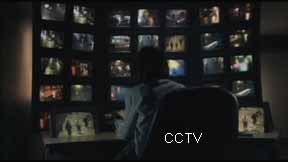
The way to enjoy: If you haven't seen it, see the movie first before you read my thoughts on it. I found it almost impossible to write about this movie without spoiling the suspense. As you watch the movie, though, some things you might not otherwise pay attention to are: the shots of animals (dogs, birds, sharks); the many references to smoking (“fags”). Keep your eyes peeled for films within this film.
A caution: Don't be fooled. This isn't a simple-minded film about revenge being replaced by a sugary forgiveness and redemption.

This film builds on the City Eye closed-circuit television surveillance system in Glasgow, Scotland. All over Great Britain, cities have adopted these systems in hopes of reducing crime and helping people in distress. They provide the opening and closing shots of this movie.
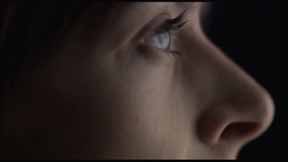 Its heroine is Jackie (Kate Dickie) who operates a bank of (CCTV) cameras, staring all day into a wall of television screens that pick up street activity. She smiles benevolently as she sees random acts of kindness on her screens, someone helping a
Its heroine is Jackie (Kate Dickie) who operates a bank of (CCTV) cameras, staring all day into a wall of television screens that pick up street activity. She smiles benevolently as she sees random acts of kindness on her screens, someone helping a
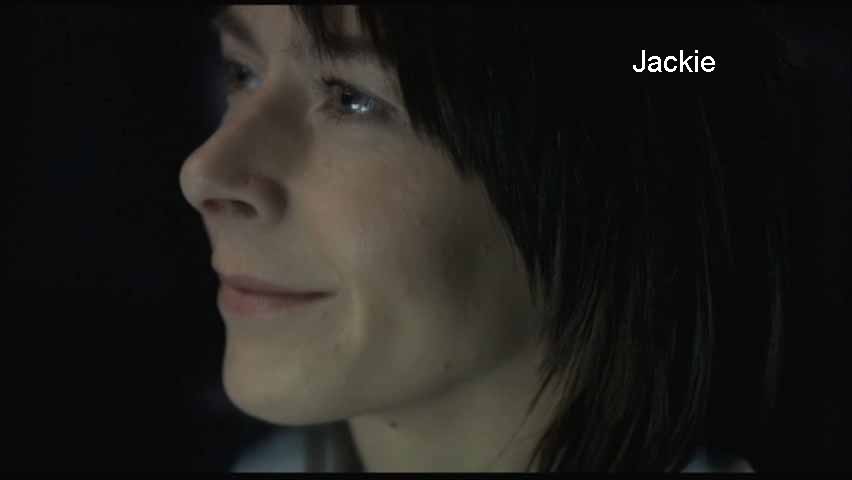 cleaning woman, for example. Jackie has come to know, in this distant way, some of the characters in the show she watches. We, of course, watch with her, and the director (Andrea Arnold) juxtaposes shots of the screens with extreme close-ups of Jackie's eye. She is the City Eye.
cleaning woman, for example. Jackie has come to know, in this distant way, some of the characters in the show she watches. We, of course, watch with her, and the director (Andrea Arnold) juxtaposes shots of the screens with extreme close-ups of Jackie's eye. She is the City Eye.
In the course of watching, she sees Clyde Henderson (Tony Curran), a scruffy ginger-haired neanderthal, as he is having sex with a woman server from a nearby café. She recognizes him, but director Arnold carefully doles out bit by bit why he is important to Jackie. Jackie begins stalking him and watching him with her cameras, and she learns more about him. Clyde is out of prison early (for good behavior) for something he did that affected Jackie. He lives in the Red Road apartment blocks with another ex-con, Stevie (Martin Compston), scrounging old furniture from dumpsters, strange pieces of wood, buying beer for a raucous party, and so on. Stevie has a girlfriend in the apartment, April (Nathalie Press). All this, Jackie picks up from watching her CCTV cameras.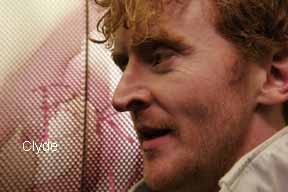
Obviously watching plays a key role in Arnold's film and one could start thinking about this film by thinking about watching. Something else intrigued me, though, and perhaps it provides a less obvious way into Red Road. Animals.
One of the characters Jackie gets to “know” is a man with an aged, sick bulldog. (She tells one of her fellow-watchers not to report the dog when it shits on the sidewalk, because it is “sick.” And her co-worker doesn’t.) When Jackie has her biweekly sex with “Avery” in his “Security Systems” truck, he turns his dog “Prince” loose while they are at it. Late in the movie, Jackie is at her in-laws, and they talk about the in-laws’ pet bird.
I began to wonder, why are there so many animals in this movie? Stray dogs wander through the Red Road neighborhood. Birds fly through the sky shots looking between the tall apartment buildings. Stevie brings April a puppy, thereby proving he is “sweet.” We see the puppy wandering through the party at Clyde's and Stevie's apartment. There are foxes at the Red Road slum, and their cries keep Stevie awake at night. We learn about the in-laws' budgerigar. The café waitress says to Clyde, “You’re a fuckin’ animal.” And Jackie says of herself, “I’m a party animal,” but in her Scottish dialect it sounds like, “I’m a part’ animal.” The last shot is of the man whose bulldog died with a new dog, and Jackie’s last words in the film are about that.
I had an odd association. What involves a lot of watching and a lot of animals? The nature movies that we see on public television. We watch animals foraging, feeding, fighting, fostering their young, and mating. And that's what we do in this movie: watch human animals foraging, feeding, fighting, fostering, and mating. Indeed, we even see a nature movie at one point: Jackie at home inspects surveillance tapes of Clyde on her own television set; what is playing on the set is a nature movie about sharks and a whale.
The surveillance cameras allow us to watch the characters in all their activities, and Andra Arnold’s cameras allow us to see even more, notably the virtually pornographic sex scene between Clyde and Jackie. Red Road lets us watch the human animal mate and prey as we watch lions or ducks or chimpanzees in nature films.
That's why, I think, we have the sex scene between Jackie and Clyde in such excrutiating, pornographic detail. The nature movies do just that. They show us animals mating in voyeuristic detail. Jackie stalks Clyde, and that is what these nature photographers do, stalk their subjects. Jackie's sitting and watching, hour after hour, her CCTV monitors—that's exactly what the nature photographers do. They sit behind their movie cameras or, more likely, like Jackie, they have the system automated. They watch and they wait until they get the shot they want.
If we think of this movie as like a nature movie, we can begin to think of the characters in the movie as animal-like. Certainly Clyde and Stevie seem brutal (to use the right word). April seems somewhat subhuman in her inabiity to articulate her life. The dancing at Jo's wedding and the later dancing at the party, how human is that?
The film contrasts its protective mode with sex. For example, at Jackie’s sister-in-law’s wedding, there is the excited dancing contrasted to Jackie’s sober watching and getting a “trifle” for an elderly relative. When, near the end of the film, Jackie dismisses her lover Avery, she tells him to “Go take care of your family.” And there are Clyde’s moves in the sex scene, moving from gently massaging Jackie’s feet to undressing her. Jackie first sights Clyde when she is wondering whether she needs to alert the police to a rape (protective mode), but then she begins to realize who he is (revenge mode begins).
We could say, until just after the sex scene, that we are watching humans as they behave in animal ways, not necessarily bestial or brutal (they are the appropriate adjectives) but the human equivalent of animals' acts: feeding, foraging, fighting, fostering, and finally mating. This mode persists until just after the sex scene when Jackie fakes the rape by getting Clyde’s semen out of the condom and smearing her genitals with it. Indeed, I'm not sure that revenge as such is part of animals' repertoire. And then Jackie goes into get-over-it mode. She decides not to prosecute Clyde. She makes up with her in-laws. She decides to get on with her life.
The last shot finishes this transition from animal to human, from sexual to fostering, with the bulldog man. He has gotten a new dog. Jackie leans down and pats the dog and congratulates the man. Jackie's redemption takes a very specific form. She stops functioning at an animal, sexual level. She becomes empathetic. She fosters.
Protectiveness permeates the surveillance operation, and, since the cameras are mounted high up (we see pictures of them, too), the watching is watching over. The cameras are meant to be protective, and, indeed, at one point Jackie gets the police to rescue an apparently lost and disoriented twenty-year-old girl. But in watching Clyde, she is not being protective, but something else that we gradually learn. Again and again, the characters are smoking or asking, “Gimme a fag.” They are dependent, needing.
(Parenthetical cultural comment: In the highly individualistic U.S., proposals to install such cameras evoke outraged howls of “Big Brother” and “invasion of privacy.” In the more community-minded U.K., people have tended to accept this surveillance in the name of protecting the public, particularly its more vulnerable members, even though the evidence that CCTV reduces crime is slight. Because of this cultural difference, U.S. viewers are likely to be less sensitive to the theme of protectiveness that I think so pervades this film.)
In the course of the film, we see various people protecting other people: the surveillance team protects Glaswegians; Clyde protects his roommate Stevie in a barroom brawl; Stevie protects Clyde after Jackie has achieved her revenge; the man protects his bulldog; the City Eye operators protect the street girl. Avery (Jackie’s perfunctory lover) drives a “Security Systems” truck. Clyde is trying to be a locksmith.
Closely allied to this concern with protection are the locales of the film. There is the lawless and poor Red Road neighborhood with its sex and violence. Then there are the caring middle-class locales: (the surveillance operations center; Jackie’s home; her in-laws’ home). These become associated with family, marriage, job, and, in general caring environments. Cool blues and pastels mark the middle-class caring environments, strident reds and oranges the lawless world of Red Road. Similarly, the film contrasts open environments with tightly confined spaces (often corridors) in which you have to come close-up and face-to-face with someone you might like not to be seen by, someone you would like to avoid.
Much of the idea of protection in this film has to do with parenting. We see a variety of parents: Jackie and her dead husband’s parents; Clyde and his daughter; Stevie and his violent fight with his “dad.” At the end of the movie, we have gradually learned that Jackie was married, had a child, and both husband and daughter were killed when Clyde, doped up on crack, drove into a bus stop. At the end of the movie, Jackie’s mother-in-law gives her a warm hug. Earlier a rape counselor had given her “comfy” clothes. Even brutal Clyde wants to be a father to his daughter.
At the end Jackie tells Clyde that she grieves because she failed to protect her husband and daughter. In fact, the last words she spoke to her daugher ordered her “out of my sight” (surveillance?). There are other violations of protectiveness, notably Stevie’s pretending to throw his girlfriend out the twenty-fourth storey of the Red Road apartment building or Stevie’s beating up on his aged father.
Contrasted to sight, then, is touch, which is intimate, which can be loving, and can be hostile. There are the fights and the dancing and the virtually pornographic sex scene between Jackie and Clyde. There is Clyde licking his plate in the café and later licking Jackie’s cunt. He pretends to be a fireman and carries Jackie “up the road” for their sex. Having denied her father-in-law the final dispersal of her husband’s ashes, Jackie goes to bed clutching the bronze urns that hold the ashes of her husband and daughter. “I want them here with me.” In one of the most touching (no pun intended) scenes, Jackie gets out her dead daughter’s drawings and books and clothes. She stuffs a snow suit with clothing and holds it to her as if it were the dead daughter herself. 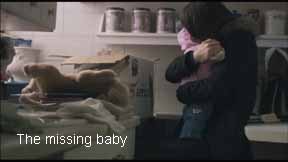 She has to feel the child. it is after this moment that, having dropped the rape charge against Clyde, she talks to him, trying to understand what he did and to get him to understand what she has done and why.
She has to feel the child. it is after this moment that, having dropped the rape charge against Clyde, she talks to him, trying to understand what he did and to get him to understand what she has done and why.
This film was made under odd circumstances. The group, Advance Party, adopted some of the Dogme principles about hand-held camera, filming on location, and the like, But they also got three first-time directors to agree each to make a film based in Glasgow on characters created by Anders Thomas Jensen. Andrea Arnold agreed, and, astonishingly, this is her first-full length feature (although her earlier shorts won prizes). If movies be telling stories through images, she has a great future.
You could read this picture very simply, as Jackie’s revenge replaced by redemption. You could read it as the competing desires behind a surveillance system like Glasgow's City Eye. On the one hand there is the desire to protect; on the other, the desire to pry into people's private lives (particularly their sex). But these issues run very deep in the human psyche. Helen Fisher, anthropologist at Rutgers University, has famously shown how the brain uses different systems for lust, for romantic attraction, and for affection. When one turns on, the others turn off. In psychoanalytic terms, the tension between two of these (lust-attraction) and affection is what makes the oedipus complex. We desire mothering, but we also desire mother. Looked at this way, this remarkable film probes the very core of human relationships.